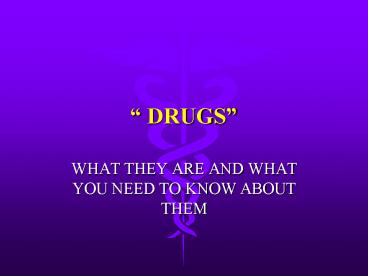DRUGS - PowerPoint PPT Presentation
1 / 19
Title:
DRUGS
Description:
Psychological Dependence-a strong desire to continue using a drug for emotional reasons. ... Fatal OD is possible. Club Drugs-Date Rape Drugs. MDMA, Ecstasy, STP etc. ... – PowerPoint PPT presentation
Number of Views:97
Avg rating:3.0/5.0
Title: DRUGS
1
DRUGS
- WHAT THEY ARE AND WHAT YOU NEED TO KNOW ABOUT THEM
2
TERMINOLOGY
- Tolerance-a condition in which the body becomes
used to a substance. - Physical Dependence-a condition in which a person
develops tolerance to a drug and the drug becomes
necessary or the person has withdrawal symptoms. - Psychological Dependence-a strong desire to
continue using a drug for emotional reasons.
3
TERMS cont
- Withdrawal-unpleasant reactions that occur when a
person who is physically dependent on a drug no
longer takes it. - Dependence-continued use of a drug even though it
harms the body, mind, and relationships.
4
Progression to Dependence
- Experimentation-trying it
- Desired Effect-getting high
- Tolerance
- Denial-refusing to admit problem
- Dependence
- Avg. cost of rehab 20-30 thousand/month
- Avg. age of experimentation13 yrs. old
5
Marijuana
- Gateway drug-drug whose use increases the
likelihood that a person will use other harmful
drugs. - THC-drug that produces psychoactive effects.
15-20x stronger than the 70s. - (8-15)
6
Narcotics
- A group of drugs that slows down the CNS and
relieves pain. - Analgesic-relieves pain
- Opium-seedpod of poppy
- Morphine-found naturally in Opium
- Codeine-painkiller produced from Morphine
- Heroin-Illegal narcotic derived from Morphine.
- Opiates - Maybe you've heard of drugs called
heroin, morphine or codeine. These are examples
of opiates. If someone uses opiates again and
again, his or her brain is likely to become
dependent on them.
7
Sedative-Hypnotics
- Tranquilizers and Sleeping pills/aids
- A group of drugs that depresses the activities of
the CNS. - Sedativedrug that has a calming effect on a
persons behavior. - Hypnotica drug that produces drowsiness and
sleep
8
Types of S-H
- Barbiturates-prescribed sleeping aids that are
very addictive and dangerous. - Benzodiazepines-prescribed to treat anxiety
- Rohypnol-date rape drug
9
Hallucinogens
- A group of drugs that interfere with the senses
and cause hallucinations. - LSD, PCP, Mescaline, Psilocybin, MDMA
- -Tolerance/effects last from hours to days,
depending on dose and the individuals
sensitivity. - -Flashbacks/visual, recur long after the drug is
taken.
10
Hallucinogens cont
- Bad Trips
- -panic attacks, severe depressive episodes,
- schizophrenia, short-lived, usually ending in 24
hrs. PCP can last for days, death can also occur. - Treatment
- -dependence is rare, OD rare, psychological
- dependence occurs.
11
Inhalants
- Substances that are gases or emit gases at room
temperature. - Household or industrial chemicals.
- Inhaled by sniffing or huffing w/a bag.
- Vapors rush quickly to the brain and will last
3-30 minutes.
12
Anabolic Steroids
- Ergogenic-used to improve athletic performance.
- Banned from USOC, IOC.
- Cycling-taking multiple doses in a specific
period of time, stopping, and starting again. - Powerful, synthetic derivatives of testosterone
that produce muscle growth by stimulating protein
synthesis.
13
Effects of Steroids
- Major-liver tumors, jaundice, fluid retention,
and high BP. - Men-shrinking of the testicles, reduced sperm
count, infertility, baldness, development of
breasts. - Women-growth of facial hair, change in or
cessation of the menstrual cycle, deepened voice. - Adolescents-growth halted prematurely through
premature skeletal maturation, accelerated
puberty changes.
14
Depressants
- Drug that depresses the CNS.
- Quaaludes, Secanol, Valium, and Alcohol.
- Barbiturates are also classified as a depressant
even though they are S-H.
15
Stimulants
- A group of drugs that speed up the activities of
the CNS. - Uppers feel alert, awake, and active.
- Increases BP, HR, and breathing rate.
- Cocaine, crack, amphetamines, meth, ephedrine,
and caffeine.
16
Cocaine and Crack
- Highly addictive stimulant that is obtained from
the leaves of the coca bush. - Purified cocaine that is smoked, to produce a
rapid and intense reaction. - Trying these once can be fatal.
- Crack can become rapidly addictive.
17
Cocaine
- Acute cases result in cocaine psychosis,
hallucinations of coke bugs. - Sniffing results in regular nose bleeds,
burns/sores in nasal membranes, sore throats,
hoarseness, shortness of breath, cold sweats, and
controlled tremors. - Heavy useangina, irregular heartbeat,
malnutrition, weight loss, lack of sleep, neglect
hygiene, lower immune system, TB, infections. - IV user- HIV/AIDS, Hepatitis
- Free basers-harm lungs
- Tolerance occurs very quickly.
18
Crack
- 1985, smoke able form
- Almost pure Cocaine
- Inexpensive, slivers of soap
- 7 seconds to enter bloodstream
- Physical and psychological dependence
- Tolerance develops quickly
- Fatal OD is possible
19
Club Drugs-Date Rape Drugs MDMA, Ecstasy, STP
etc. Commonly come in pill form, but may be
various colors with different logos. Memory loss
and lack of memory retention

